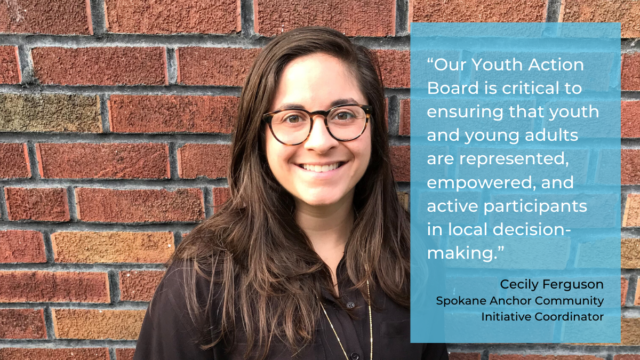Communities around the state have been rallying to support young people experiencing housing instability as the COVID-19 outbreak unfolds, and our Anchor Communities are no exception. Anchor Community Core Team meetings have provided a space for communities to strategize around ways to respond to young people’s needs during these difficult times. Check out the strategies Spokane and Walla Walla have implemented to better serve young people:
Spokane
Spokane has an established Youth Action Board (YAB) that informs youth and young adult homelessness work in the community. Following public health guidelines, YAB meetings shifted from being in-person to being online, and the community noticed a decrease in participants. The team knew that without an active YAB, their work could not move forward.
“Our Youth Action Board is critical to ensuring that youth and young adults are represented, empowered, and active participants in local decision-making,” said Cecily Ferguson, our Spokane Anchor Community Initiative Coordinator. “The group informs improvement projects and reduction strategies for the Anchor Community Initiative, and one member sits on our Continuum of Care as a voting member to help shape our homeless services system.”

Spokane set an attendance goal of 10 young people per meeting and created a plan to achieve this goal at a recent Anchor Community Core Team meeting. The team decided to:
- Create informational materials explaining the YAB to garner interest
- Team members volunteered to reach out directly to 1-3 young people each to invite them to join the YAB
- Identify any technological barriers that keep young people from attending these meetings and troubleshoot these barriers
After implementing these action items, two young people joined the meeting for the first time after being referred by community partners. They came prepared to the meeting and were engaged, enthusiastic, and thoughtful in their feedback and conversation, and ended the meeting interested in staying involved. The team will continue their outreach efforts towards the goal of reaching 10 total participants per meeting.
Walla Walla
The LOFT is an under-18 HOPE Center run by Catholic Charities in Walla Walla. As the community’s efforts to house young people amidst the pandemic intensified, shelter beds remained open at The LOFT. The Anchor Community Core Team used their meetings to identify the following barriers and solutions to ensure youth could access these beds:
- Knowledge that The LOFT remained open – With in-person outreach diminished, the team created electronic flyers to advertise broadly that The LOFT remained open. The flyers were distributed through social media and to partners like schools who remained in contact with youth.
- The LOFT policies – When our state’s stay-at-home order went in place, The LOFT had to implement more safety measures and secure schedules. The team heard feedback that some youth accessing services found these measures too restrictive. The LOFT decided to implement morning conversations with youth to talk about and adjust the daily schedule in a way that felt more empowering to youth.
- Direct outreach – The LOFT staff committed to follow up with youth who had previously accessed their services, to check in and provide information about resources and services that remain available.
“School closures, in-person support group cancellations, and limited access to technology are making it harder for youth to stay connected and gain access to resources,” said Samantha Jackle, our Walla Walla Anchor Community Initiative Coordinator. “We want to stay diligent and ready to adapt our outreach and case management efforts based on the needs of youth in Walla Walla County.”

After the team made information available broadly and through partners, the referral rate from DCYF increased. Youth also began to stay longer after The LOFT staff began morning conversations.

